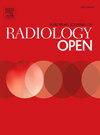使用磁共振成像T1ρ和T2映射检测膝关节结构的运动相关变化
IF 2.9
Q3 RADIOLOGY, NUCLEAR MEDICINE & MEDICAL IMAGING
引用次数: 0
摘要
目的应用磁共振成像(MRI) T1ρ和T2成像评价运动前后膝关节各种结构的变化。方法对12名健康志愿者在跳绳、屈伸和静止前后进行右膝mri检查。根据T1ρ和T2值定量评估关节软骨、前后交叉韧带、内侧和外侧半月板、腓肠肌和Hoffa脂肪垫的不同部位。采用配对t检验来确定各种活动对不同部位膝关节结构的影响是否有统计学差异。结果跳绳后外侧半月板的T1ρ值降低,腓肠肌的T1ρ值和T2值均升高。在半月板、交叉韧带和Hoffa脂肪垫的其他部位无统计学差异。跳绳后股骨和胫骨承重软骨的T1ρ和T2值均降低。然而,在屈伸和静止后的软骨中,没有观察到统计学上的显著差异。结论smri T1ρ和T2测图可用于评价运动前后各关节结构的变化。膝关节组织的这些变化被推测为反映了组织液、胶原纤维和蛋白多糖含量的变化。需要进一步的研究来研究运动对关节结构的影响,使用MRI成像技术。本文章由计算机程序翻译,如有差异,请以英文原文为准。
Exercise-related changes in knee articular structures detected using magnetic resonance imaging T1ρ and T2 mapping
Purpose
To evaluate the changes in various knee joint structures before and after physical activities using magnetic resonance imaging (MRI) T1ρ and T2 mapping.
Methods
MRI of the right knee was performed for 12 healthy volunteers before and after jumping rope, flexion and extension, and at rest. Different parts of articular cartilage, anterior and posterior cruciate ligaments, medial and lateral meniscus, gastrocnemius muscle and Hoffa’s fat pad were quantitatively assessed based on T1ρ and T2 values. A paired t-test was performed to determine whether the effects of various activities on different parts of the knee articular structures were statistically different.
Results
The T1ρ values for the lateral meniscus decreased, while both T1ρ and T2 values for the gastrocnemius muscle increased after jumping rope. No statistically significant differences were observed in the other parts of the meniscus, cruciate ligaments, and Hoffa’s fat pad. The T1ρ and T2 values for the weight-bearing cartilages of the femur and tibia were both reduced after jumping rope. However, no statistically significant differences were observed in the cartilage after flexion and extension or at rest.
Conclusions
MRI T1ρ and T2 mapping can be used to evaluate the changes in various joint structures before and after physical activities. These changes in knee tissue were hypothesized to reflect variations in tissue fluid, collagen fibers, and proteoglycan content. Further studies are required to investigate the influence of exercise on articular structures using MRI mapping techniques.
求助全文
通过发布文献求助,成功后即可免费获取论文全文。
去求助
来源期刊

European Journal of Radiology Open
Medicine-Radiology, Nuclear Medicine and Imaging
CiteScore
4.10
自引率
5.00%
发文量
55
审稿时长
51 days
 求助内容:
求助内容: 应助结果提醒方式:
应助结果提醒方式:


